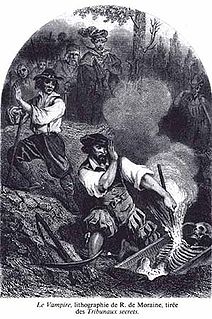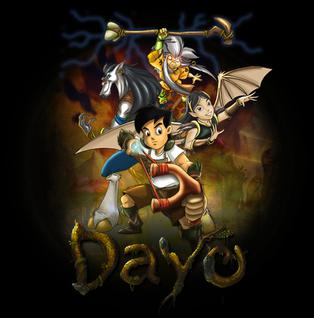Related Research Articles

A vampire is a creature from folklore that subsists by feeding on the vital essence of the living. In European folklore, vampires are undead creatures that often visited loved ones and caused mischief or deaths in the neighborhoods they inhabited while they were alive. They wore shrouds and were often described as bloated and of ruddy or dark countenance, markedly different from today's gaunt, pale vampire which dates from the early 19th century.

The manananggal is an old mythical creature in the Philippines that separates from their lower part of body and their fangs and wings give it a vampire-like appearance.

Aswang is an umbrella term for various shape-shifting evil creatures in Filipino folklore, such as vampires, ghouls, witches, viscera suckers, and werebeasts. The Aswang is the subject of a wide variety of myths, stories, arts, and films, as it is well-known throughout the Philippines. Spanish colonists noted that the Aswang was the most feared among the mythical creatures of the Philippines, even in the 16th century. Although with no specific motive other than harming others, their behavior can be interpreted as an inversion of the traditional Filipino's values. The Aswang is especially popular in Visayas, southern parts of Luzon, and parts of Mindanao, including Capiz.

Philippine mythology is the body of stories and epics originating from, and part of, the indigenous Philippine folk religions, which include various ethnic faiths distinct from one another. Philippine mythology is incorporated from various sources, having similarities with Indonesian and Malay myths, as well as Hindu, Muslim, Shinto, Buddhist, and Christian traditions, such as the notion of heaven, hell, and the human soul. Philippine mythology attempts to explain the nature of the world through the lives and actions of heroes, deities, and mythological creatures. The majority of these myths were passed on through oral tradition, and preserved through the aid of community spiritual leaders or shamans and community elders. Diwata is recognized as the universal supreme deity who is above all other supreme deities from different religions.

The Sigbin or Sigben is a creature in Philippine mythology said to come out at night to suck the blood of victims from their shadows. It is said to walk backwards with its head lowered between its hind legs, and to have the ability to become invisible to other creatures, especially humans. It resembles a hornless goat, but has very large ears which it can clap like a pair of hands and a long, flexible tail that can be used as a whip. The Sigbin is said to emit a nauseating odor.
The Pugot is a mythical fiend that is found in the folklore of the Ilocos region of the Philippines. It can assume various shapes such as hogs, dogs or even as humans. However, it usually appears as a black, gigantic headless being. The creature usually resides in dark places or deserted houses. However, they especially like living in trees such as the duhat, santol, and tamarind.
The penanggal or penanggalan is a nocturnal vampiric entity from Malay ghost myths. Its name comes from the word tanggal meaning to remove or take off, because its form is that of a floating disembodied woman's head with its trailing organs still attached. From afar, it twinkles like a ball of flame, providing an explanation for the will-o'-the-wisp phenomenon.
Pedro Penduko is a Filipino comic book character styled as a folk hero or superhero, created by National Artist for Literature Francisco V. Coching and debuted on the magazine Liwayway.
The Tiyanak is a vampiric creature in Philippine mythology that takes on the form of a toddler or baby. Although there are various types, it typically takes the form of a newborn baby and cries in the jungle to attract unwary travelers. Once it is picked up by an unfortunate passerby, it reverts to its true form and attacks the victim. The tiyanak is also depicted to take malevolent delight in leading travelers astray, or in abducting children.
Mythic humanoids are mythological creatures that are part human, or that resemble humans through appearance or character.

Legends of vampires have existed for millennia; cultures such as the Mesopotamians, Hebrews, ancient Greeks, and Romans had tales of demonic entities and blood-drinking spirits which are considered precursors to modern vampires. Despite the occurrence of vampire-like creatures in these ancient civilizations, the folklore for the entity we know today as the vampire originates almost exclusively from early 18th-century Southeastern Europe, particularly Transylvania as verbal traditions of many ethnic groups of the region were recorded and published. In most cases, vampires are revenants of evil beings, suicide victims, or witches, but can also be created by a malevolent spirit possessing a corpse or a living person being bitten by a vampire themselves. Belief in such legends became so rife that in some areas it caused mass hysteria and even public executions of people believed to be vampires.

Surviving Evil is a 2009 horror film directed and written by Terence Daw, and produced by David Pupkewitz, Anton Ernst and Malcolm Kohll. It stars Billy Zane, Christina Cole, Natalie Mendoza and Louise Barnes. The screenplay concerns six documentary filmmakers who attempt to survive their visit to a Philippine island to shoot a survival special when they discover that the shape shifting, bloodthirsty Aswang, a creature of Philippine folklore inhabits the island.

Dayo: Sa Mundo ng Elementalia is a 2008 Filipino animated adventure-fantasy comedy film and the Philippines' first all-digital full-length animated feature film. Produced by Cutting Edge Productions, the film revolves around Bubuy who has to save his grandparents who were abducted and brought to the strange land called Elementalia, home to a host of strange creatures from Philippine mythology. This $1.3 million production composed of over 500 local animators features a “tra-digital animation” technique using paperless 2D and 3D technologies. It has 2D animation for its characters and 3D animation for the backdrops.
The Wakwak is a vampiric, bird-like creature in Philippine mythology. It is said to snatch humans at night as prey, similar to the Manananggal and the Ekek in rural areas of the Philippines. The difference between the Manananggal and the Wakwak is that Wakwak cannot separate its torso from its body while the Manananggal can. Some believe the Wakwak is a form of vampire. Other people contend that a Wakwak is a Philippine night bird associated with witches.
Amalanhig are creatures in Visayan mythology, particularly among Hiligaynon speaking groups. Amalanhig are Aswangs who failed to transfer their monstrosity causing them to rise from their graves to kill humans by biting their necks. Another version that has survived through word-of-mouth recounts that Amanlanhigs are said to chase any living person they found and once they reach them, they would tickle the victim until they die, both of laughter and terror. In order to escape from Amanlanhigs, one runs in zigzag direction since they can only walk in straight direction due to the stiffness of their body. One would also climb trees or high platforms enough to be out of their reach. One would also run into lakes and rivers since Amanlanhigs are scared of deep bodies of water.

Aso ni San Roque is a Philippine television drama fantasy series broadcast by GMA Network. Directed by Don Michael Perez, it stars Mona Louise Rey. It premiered on September 10, 2012 on the network's Telebabad line up replacing Makapiling Kang Muli. The series concluded on January 11, 2013 with a total of 90 episodes. It was replaced by Indio in its timeslot.
Aswang is a 2011 Filipino action horror thriller film based on the Filipino mythical creature that is a shapeshifting monster usually possessing a combination of the traits of either a vampire, a ghoul, a witch, or different species. The film is directed and co-written by Jerrold Tarog. It stars Lovi Poe, Paulo Avelino, Albie Casiño, Jillian Ward, Marc Abaya and Niña Jose. The film is a remake of Peque Gallaga's 1992 film of the same name.
References
- ↑ PERTIERRA, RAUL (1983). "Viscera-Suckers and Female Sociality: The Philippine Asuang". Philippine Studies. 31 (3): 319–337. JSTOR 42633556.
- ↑ Bane, Theresa (2012-01-09). Encyclopedia of Demons in World Religions and Cultures. McFarland. ISBN 9780786488940.
- ↑ Ramos, Maximo (1969). "The Aswang Syncrasy in Philippine Folklore". Western Folklore. 28 (4): 238–248. doi:10.2307/1499218. JSTOR 1499218.
- ↑ Ramos, Maximo D. (1990). Creatures of Philippine lower mythology. Phoenix Pub. House.
- ↑ Lansdale, Edward Geary (1991). In the Midst of Wars: An American's Mission to Southeast Asia. Fordham Univ Press. ISBN 978-0-8232-1314-6.